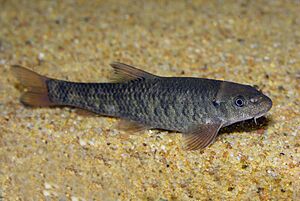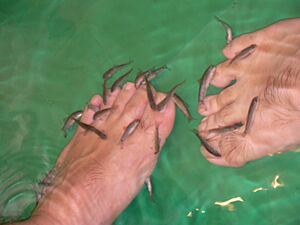Doctor fish facts for kids
The red garra (Garra rufa) is a small freshwater fish. People also call it the doctor fish or nibble fish. It comes from rivers and streams in warm parts of Western Asia. These fish are usually about 14 centimeters (5.5 inches) long, but some can grow up to 24 centimeters (9.5 inches).
Quick facts for kids Doctor fish |
|
|---|---|
 |
|
| Conservation status | |
| Scientific classification | |
| Genus: |
Garra
|
| Species: |
rufa
|
| Synonyms | |
In the wild, red garra eat tiny bits of plants and animals found in the water. Since the early 2000s, these fish have been used in spa treatments. They gently nibble on the dead skin of people with a skin condition called psoriasis. This treatment can help make psoriasis symptoms better, but it doesn't cure the condition. Using these fish for spa treatments for everyone is still discussed. Some people wonder if it really works or if it's safe.
Contents
Where Do Doctor Fish Live?
The red garra fish originally comes from countries like Turkey, Iraq, and Iran. You can find them in many rivers, streams, and even some lakes. They usually live in moving water, but they can also survive in places like canals. They are often found in large numbers.
Understanding Different Types of Garra Fish
Scientists have found that the fish called Garra rufa might actually be several different types of fish that look very similar. This means that the "doctor fish" you see might not always be the exact same species. For example, some fish from Turkey are now called G. turcica, and some from the Jordan River area are called G. jordanica. Scientists are still studying these fish to understand them better.
Doctor Fish and People
Doctor fish spas are found in many countries around the world. In 2006, some of the first doctor fish spas opened in places like Kangal, Turkey, and Hakone, Japan. In 2008, these unique pedicure services came to the United States. However, some places quickly closed them down.
Are Doctor Fish Spas Safe?
Many places in the United States and Canada have banned doctor fish treatments. This is because beauty regulators worry about how clean the process is. Usually, tools used in spas must be cleaned or thrown away after each person. But fish can't be thrown away!
The animal rights group People for the Ethical Treatment of Animals (PETA) is against using doctor fish. They say that the fish are often moved in harsh ways and might even be starved. This would make them more likely to eat skin, which isn't their normal food.
Most of the doctor fish used in spas and sold for aquariums come from special farms in Israel and Turkey. Because scientists now know there are different types of Garra fish, it's sometimes hard to know exactly which type of fish is being used in the spas. In Turkey, it's against the law to catch these fish from the wild to protect them.
Even though these fish can live in polluted water, they need clean, moving water to be healthy in an aquarium. For treating skin conditions, fish kept in aquariums might not be as good. This is because the fish only really nibble on skin when they don't have much other food.
See also




